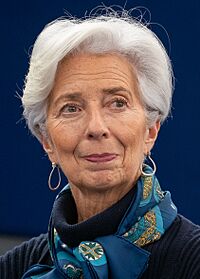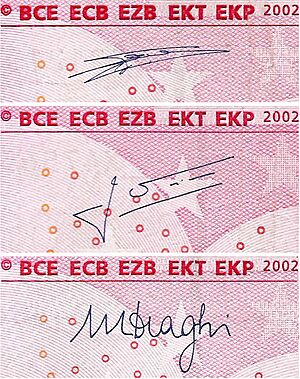President of the European Central Bank facts for kids
Quick facts for kids President of the European Central Bank |
|
|---|---|

Emblem of the European Central Bank
|
|
| European Central Bank | |
| Style | Madam President (ordinary) Her Excellency (diplomatic) |
| Member of | Executive Board Governing Council General Council |
| Reports to | European Parliament European Council Eurogroup |
| Residence | Seat of the European Central Bank |
| Seat | Frankfurt, Germany |
| Appointer | European Council |
| Term length | Eight years, non renewable |
| Constituting instrument | Treaties of the European Union |
| Precursor | President of the European Monetary Institute Euro area national central banks governors |
| Formation | 1 June 1998 |
| First holder | Wim Duisenberg |
| Deputy | Vice-President |
| Salary | €421,308 per annum |
The President of the European Central Bank is like the boss of the European Central Bank (ECB). The ECB is a very important bank that helps manage the euro currency. It also sets rules for money in the Eurozone, which is a group of countries in the European Union (EU) that use the euro.
The current President of the European Central Bank is Christine Lagarde. She started her job on November 1, 2019. Before this, she was in charge of the International Monetary Fund. Christine Lagarde is the first woman to be the President of the ECB.
Contents
What the President Does and How They Are Chosen
The President leads several important groups within the ECB. These include the Executive Board and the Governing Council. The President also represents the ECB to other countries and at big meetings, like the G20.
The European Council chooses the President. This is done by a special vote from the countries that use the euro. The President serves for eight years and cannot be chosen again.
A Look Back at Past Presidents
Wim Duisenberg: The First President
Wim Duisenberg was the first President of the ECB. He started his role on June 1, 1998. This was just before the euro currency was officially launched. Before the ECB, he led the European Monetary Institute.
There was some talk about him leaving his job early. But Duisenberg stayed in office until November 1, 2003. He passed away in 2005.
Jean-Claude Trichet: Leading Through Challenges
Jean-Claude Trichet became President in 2003. He was in charge during a tough time called the European debt crisis. He was good at keeping everyone calm and working together at the ECB.
Trichet faced some criticism, especially from the French President at the time. But the German Chancellor supported him, saying the bank should be independent. Trichet also had to make difficult choices, like buying government bonds. This helped stop countries from running out of money.
He worked hard to keep prices stable and interest rates under control. He also pushed for more unity among European countries. He believed the ECB needed more power to keep the economy strong.
Mario Draghi: "Whatever It Takes"
Mario Draghi became the next President of the ECB on November 1, 2011. He served until October 31, 2019.
During his time, Draghi helped European banks with large loan programs. These loans helped the banks during difficult economic times.
In July 2012, when there were big worries about countries in the Eurozone, Draghi made a famous statement. He said the ECB was ready to do "whatever it takes" to save the euro. He added, "And believe me, it will be enough." This statement made a huge difference. It helped calm the markets and lowered borrowing costs for countries like Spain and Italy. Many people see this moment as a turning point for the Eurozone.
Who Has Been President?
Here is a list of the people who have served as President of the European Central Bank:
| N. | Portrait | President (Born–Died) |
State | Took office | Left office | Professional background |
|---|---|---|---|---|---|---|
| 1 | 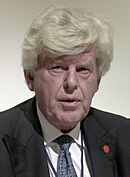 |
Wim Duisenberg (1935–2005) |
1 June 1998 | 31 October 2003 | Minister of Finance of the Netherlands; President of De Nederlandsche Bank; President of the European Monetary Institute | |
| 5 years, 153 days | ||||||
| 2 | 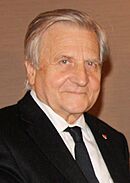 |
Jean-Claude Trichet (born 1942) |
1 November 2003 | 31 October 2011 | General Director of the Treasury at the Ministry of Finance; Governor of the Bank of France | |
| 8 years | ||||||
| 3 | 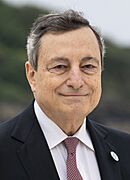 |
Mario Draghi (born 1947) |
1 November 2011 | 31 October 2019 | Managing director of Goldman Sachs; Executive Director of the World Bank; Chairman of the Financial Stability Board; Governor of the Bank of Italy | |
| 8 years | ||||||
| 4 |  |
Christine Lagarde (born 1956) |
1 November 2019 | Incumbent | Minister of Commerce; Minister of Economy, Finance and Industry of France; Managing Director of the International Monetary Fund | |
| 6 years, 52 days | ||||||
Images for kids


